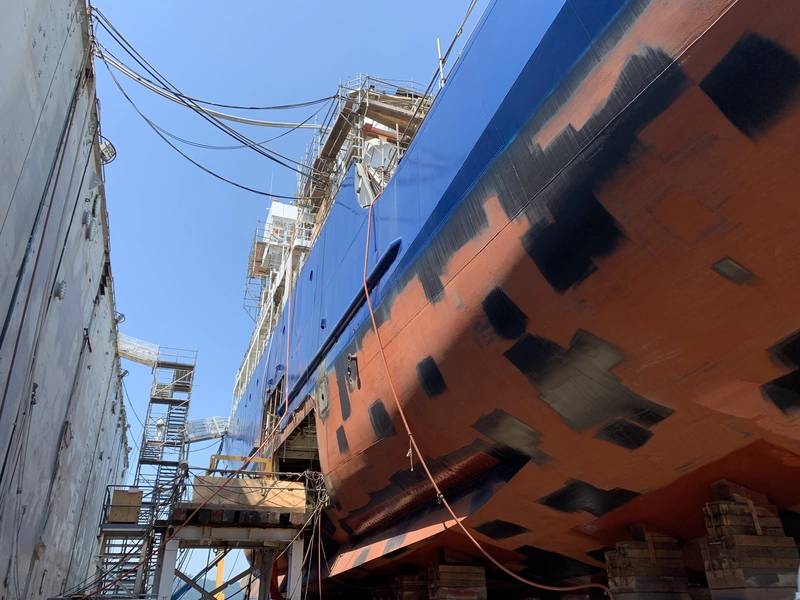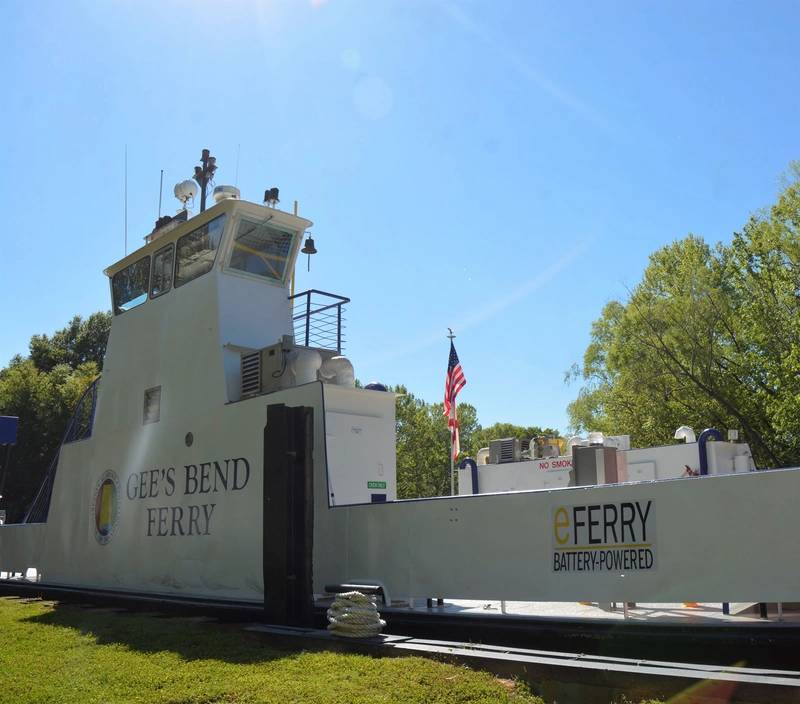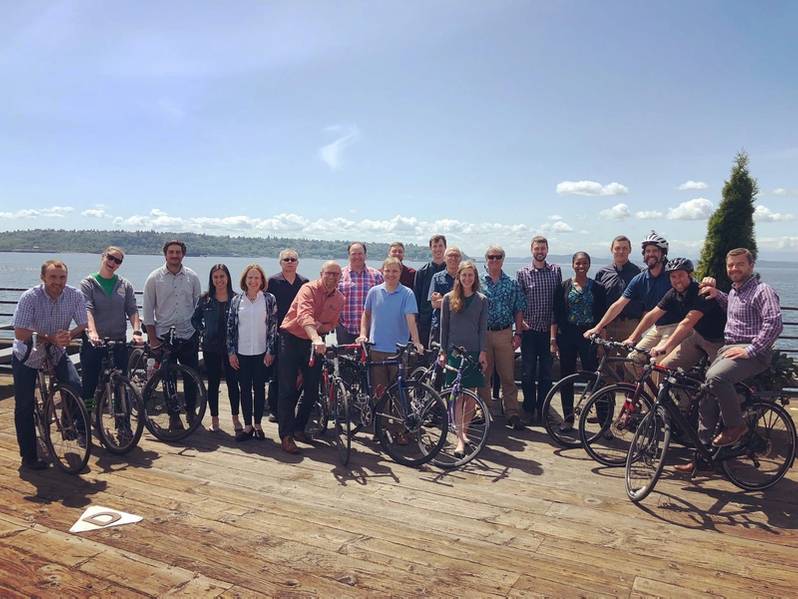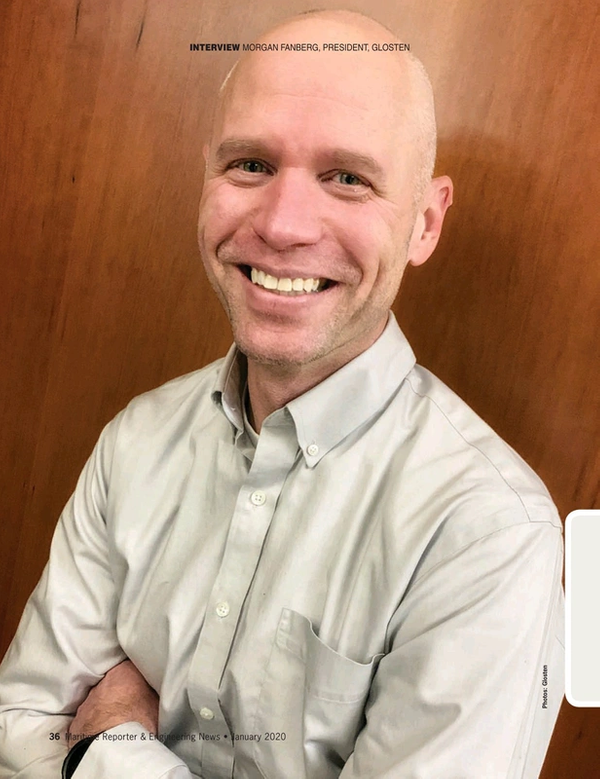
@ Glosten: “Crazy ideas are not off the table”
From racing scows on the inland lakes of Minnesota to graduating from the United States Merchant Marine Academy to taking the helm of Glosten, Morgan Fanberg has led a ‘maritime life.’ We caught up with Fanberg in his Seattle office to discuss the path ahead for one of the U.S.’ most progressive and respected naval architecture and marine engineering firms.
Morgan Fanberg has always been a ‘maritime guy,’ but his early maritime aspirations centered on racing sailboats. “I went to St. Mary’s College of Maryland to race dinghies at a collegiate level but soon realized that racing sailboats was not going to turn into a career,” said Fanberg. “I loved the boats, but I also had an underlying interest in how they worked. I liked engineering and I was good at math and physics.”
As fate had it, one weekend he participated in a sailing regatta at Kings Point and he “fell in love with the place (the United States Merchant Marine Academy [USMMA]). I applied, I was accepted, and I transferred from St. Mary’s to Kings Point in in 1994,” said Fanberg. His decision has panned out, and he credits USMMA with melding his interest in boats and engineering. “I was excited to become a marine engineer after my first semester at sea as an engine cadet,” said Fanberg. “The curriculum at Kings Point combined with applied sea-time is a perfect way to build confidence in young engineers. We all leave Kings Point knowing that we could fix anything.”
Between his junior and senior years at USMMA Fanberg earned a six-week internship at Glosten, and he immediately felt an affinity for the firm. “During my internship I was able to participate in actual vessel system design. I realized then that it was a great place to work – a great place where I could continue my career in the marine industry and where I could see my design work turn into reality.”
He joined Glosten upon graduation in 1998 and has never looked back. Ascending the ranks, his pivotal career moment was about 10 years ago when he was selected to lead the Marine Engineering group; a role that allowed him to lead larger engineering projects, develop leadership skills, and realize that one day he could lead the company. While much has changed in his 21 years with the company, today, as its leader, he strives to maintain it as a great place to work, attracting a talented crew with ample opportunity to grow personally and professionally under the Glosten banner. “Glosten has 100 employees that are looking for an amazing career, solving client’s problems in the marine industry. It’s incredible that there are that many people who share the same vision, and I feel an obligation to those people to help create career opportunities.” Through it all, Fanberg remains humble, noting that “we are an employee-owned company; I have 100 bosses – more than 40 of which are shareholders.” “Research Vessel design is interesting because each vessel is a one-off design, as these ships are usually not repeated and they are infrequently built,” said Fanberg. “Scientists and oceanographers are very involved stakeholders; they want to be a part of the design process and they want their complex research vessel to be the greatest research platform in the world.” Pictured is the R/V Roger Revelle during mid-life refit at Vigor Shipyard. Photo: GlostenFinding a Home at Glosten
“Research Vessel design is interesting because each vessel is a one-off design, as these ships are usually not repeated and they are infrequently built,” said Fanberg. “Scientists and oceanographers are very involved stakeholders; they want to be a part of the design process and they want their complex research vessel to be the greatest research platform in the world.” Pictured is the R/V Roger Revelle during mid-life refit at Vigor Shipyard. Photo: GlostenFinding a Home at Glosten
“I knew that I had found a home at Glosten,” said Fanberg. “There was already a large, talented and smart naval architecture group, but I joined Glosten’s small group of marine engineers and was exposed to a wide variety of projects.”
He credits Larry Glosten’s philosophy of ‘client service excellence’ as opening new doors and exposing staff to new opportunities, a philosophy which has engendered steady growth. When Fanberg joined the company, he was the 38th employee. At the time of this interview in late 2019, Glosten was adding its 100th employee.
“Glosten has an entrepreneurial spirit where anyone within the organization can bring ideas for new business or capabilities,” said Fanberg. “The secret to our success is our employees and our culture of mutual respect and collegiality among associates. We have hired brilliant minds that can solve any of our client’s problems. Thinking back on my early experiences at Kings Point and shipboard problem solving, I am continually amazed by our associate’s abilities to solve marine industry problems that have never been solved before.”
Finding solutions to unique problems is clearly a motivator for Fanberg and his crew. “We are still constantly drawn to unusual projects,” he said. “On a day-to-day basis, you never know what you’re going to be working on here. We don’t just do vessel design because not all of our clients are looking for a new vessel. You never know what client or challenge is going to walk through that door – you don’t know what you’re going to be working on in six months. You have to be able to solve complex problems, be flexible, and be ready to think out of the box.”
As the complexity of the projects and solutions grew, so too did Glosten.
“When I started, a large portion of our work was focused on preliminary or contract level design packages or highly analytical problem solving,” said Fanberg. “As we have grown in employees, we have also grown in technical capability. Our clients turn to us to solve more of their problems in more detail, so we have adjusted to meet this demand.”
Most recently that customer demand has been to supply electrical solutions to solve some of the pressing emission and fuel-cost-saving demands. Historically, we all dabbled in electrical engineering, but that world has completely changed, said Fanberg. “We have our own electrical engineering group now with seven electrical engineers. The focus on electric propulsion systems and propulsion systems integration has really taken on a life of its own.” All-electric Gee’s Bend Ferry. Photo: GlostenConsult and Deliver
All-electric Gee’s Bend Ferry. Photo: GlostenConsult and Deliver
Part of the Glosten value proposition is the fact that it does not promote a common book of off-the-shelf solutions. While it maintains a 61-year-old long and strong base of intelligence, the ‘consultation’ gene is woven into its DNA.
“Glosten employees have an overwhelming desire to solve our client’s problems by engaging deeply with them,” explained Fanberg. “If we can develop a relationship with a client that is based on trust and great work, job satisfaction is off the charts. Ultimately, the work we do here is supporting our client’s businesses with engineering excellence and unmatched problem solving.”
While Glosten carries a diverse clientele and workload, Fanberg admits that its work in the Research Vessel niche – started with Larry Glosten’s work with two oceanographers to develop the Floating Instrument Platform, more affectionately known as ‘FLIP’, with the Scripps Institution of Oceanography at UCSD – is work that truly sets the company apart.
“Research Vessel design is interesting because each vessel is a one-off design, as these ships are usually not repeated and they are infrequently built,” said Fanberg. “Scientists and oceanographers are very involved stakeholders; they want to be a part of the design process and they want their complex research vessel to be the greatest research platform in the world.” From FLIP to the floating golf green that Glosten designed for The Coeur d’Alene Resort, Glosten thrives on unique, technically challenging projects. Another under this category, to which Fanberg has a close affinity, is the SBX project (pictured below), a self-propelled semi-submersible modified oil-drilling platform developed for the U.S. Government’s Sea-Based Test X-Band Radar (SBX) in support of its ground-based midcourse missile defense system. “That was a massive project we did with Boeing; a hallmark project for me because of the amount of blood, sweat and tears I put into it,” said Fanberg, noting that this one project alone took Glosten from 40 to 65 people.
While he respects the past, Fanberg astutely keeps an eye on the future. “It’s easy to focus on the past, but the things we’ve designed and worked on since – an icebreaking research vessel, wave energy converters, all-electric ferries – have really pushed us in new and exciting directions.”
 From Larry Glosten to the steadily growing Glosten team, Fanberg says “Glosten has 100 employees that are looking for an amazing career, solving client’s problems in the marine industry ... we are an employee-owned company; I have 100 bosses – more than 40 of which are shareholders.” Photos: Glosten“Crazy Ideas are NOT Off the Table”
From Larry Glosten to the steadily growing Glosten team, Fanberg says “Glosten has 100 employees that are looking for an amazing career, solving client’s problems in the marine industry ... we are an employee-owned company; I have 100 bosses – more than 40 of which are shareholders.” Photos: Glosten“Crazy Ideas are NOT Off the Table”
It is generally agreed that the marine industry is in a transcendent period, with the emission reduction, autonomy and digitalization all simultaneously conspiring to impact marine asset design, maintenance and operation for the coming generation. On the ‘green’ side decarbonization is the holy grail, and while it is generally agreed that there is no ‘silver bullet’ solution, Fanberg believes there could be one.
“I would love to design an all nuclear ship,” he said. “I understand the cost, the red tape, and the bureaucratic issues, but If you’re seriously looking for a zero-emission technology to power ocean-going vessels, nuclear should be an option worth discussing. Hydrogen and ammonia are also possible future fuels for the marine industry, but the technology isn’t quite there yet.”
While the notion of a nuclear commercial fleet is unthinkable to most, it goes part and parcel to the Glosten philosophy. “We do a lot of brainstorming sessions at Glosten and the rule is ‘anything goes,’” said Fanberg. “We set aside time for Research and Development. We have a program in place to encourage our staff to bring ideas to our internal R&D advocacy group. Our R&D efforts are important for the future of Glosten and the future of the industry. We are not going to survive as a naval architecture and marine engineering firm if we are not thinking about how this industry is going to change, as it is already changing rapidly.”
While he understands the value of thinking 10 years ahead, the practical business side of Fanberg knows the importance of serving his client’s needs today.
“(Today) there’s certainly a driver to be more cost efficient, to cut fuel costs while looking at ways to adopt green technologies. Whether its legislative or societal pressure, there is a push to move away from burning fossil fuels,” said Fanberg. “We want to help our clients navigate any of their problems that need to be solved. Our efforts on purely electric ferries or hybrid propulsion is a result of both emissions and maintenance cost pressures. We have three electric ferry projects under our belt, and we are actively working on new ideas for other all-electric vessels.”
To many, autonomy in the traditionally conservative maritime sector may be a challenge to hurdle 10 years down the road, but to Fanberg and his crew, the focus is clear. “I certainly don’t have a crystal ball, but I can tell you that if there’s anyone in this business that is not paying attention to the world of autonomy and how it applies to our industry, they are not forward thinking.” While he admits that many of the autonomy opportunities today are on the government side, autonomy and all that it entails will significantly impact the commercial space.
“The other aspect of autonomy is big data, and how that loops back into our design work,” said Fanberg. “We have 61 years of design history here at Glosten. To ignore that data, and how it can feed into more efficient designs in the future, would be foolish. We are looking back at our designs and envisioning ways to come up with internal tools to help us bring new designs to our clients quicker, more efficiently, and cheaper.”
Read @ Glosten: “Crazy ideas are not off the table” in Pdf, Flash or Html5 edition of January 2020 Maritime Reporter
Other stories from January 2020 issue
Content
- Training Tips for Ship: #8 - The Lecture is Dead page: 10
- Offshore Wind: The Domino Effect page: 14
- IMO2020: Low Sulfur Fuel Potential Pitfalls page: 16
- Want to Cut Emissions? SLOW DOWN page: 18
- Anatomy of a Marine Casualty Investigation page: 24
- Anatomy of a Marine Casualty Investigation page: 24
- Ship Repair: How to Foil Well-laid Plans page: 28
- Are OSVs Fit for Refit for Offshore Wind? page: 32
- @ Glosten: “Crazy ideas are not off the table” page: 36
- Ship Repair: Bayonne Drydock Invests in Shiplift page: 42


